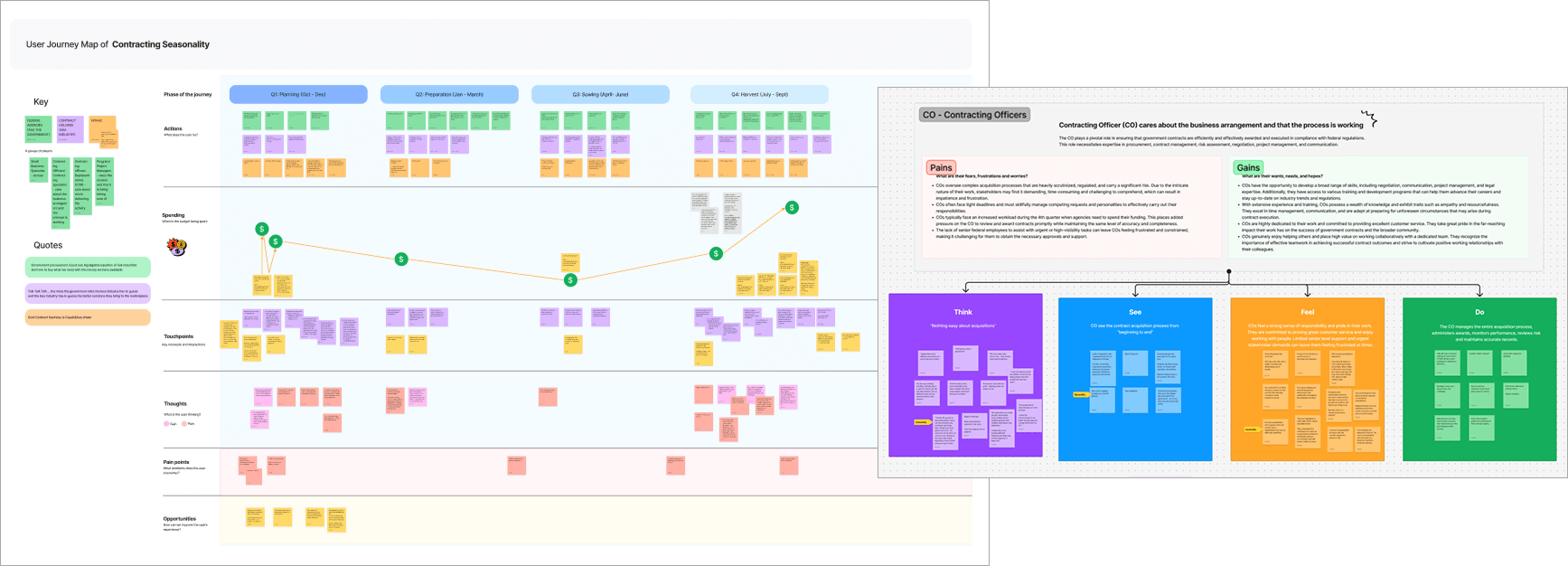Modernizing Federal Acquisition Training
OVERVIEW
How can we help federal professionals feel more confident navigating complex acquisition processes through modern, self-paced learning?
Our team partnered with NITAAC to modernize how federal acquisition professionals learn to use the agency’s government-wide acquisition contracts (GWACs). Training had long relied on live webinars and in-person sessions, which were effective in small settings but difficult to scale for a dispersed workforce.
To address this, we created NITAAC University: an online, self-paced learning platform designed to deliver modular, accessible courses federal employees can complete anytime.
The MVP launched with Introduction to NITAAC GWACs, offering learners Continuing Learning Points (CLPs) for completing the course and setting the stage for an expanding catalog of on-demand learning.

-
Company
Project completed while employed at Aleut Federal for client NITAAC.
-
Role
UX Team Lead and Product Owner
-
Team
Instructional Designer, Visual Designer, Graphic Designer, PM, FE Developer and BE Developers, QA, and Scrum Master.
THE CHALLENGE
Stakeholders envisioned a modern, interactive learning experience comparable to commercial LMS platforms, but it needed to be built within the agency’s existing infrastructure and meet rigorous federal standards for accessibility, security, and compliance—all on an eight-month timeline.
UX research showed that users were busy professionals, often cognitively overloaded, who needed training to earn CLPs but struggled to fit it into their schedules. They valued clarity, concise content, and a guided experience that made learning feel approachable and efficient.
As the UX Lead and Product Owner, I helped guide the product vision and kept every discipline connected—aligning user needs, business goals, and technical feasibility so the experience remained cohesive and achievable from concept to launch. In parallel with platform delivery, our UX team also supported the rebranding of the newly launched NITAAC University and developed the communication plan for rollout and future course announcements.
DISCOVERY AND RESEARCH
During discovery, we focused on helping the team, especially newer members, gain a deeper understanding of NITAAC’s customers and the seasonal context they operate in. This shared foundation led to the creation of learner, instructor, and admin personas that grounded our design and development efforts.
As part of early strategy and evaluation, our UX team contributed to the selection process for the LMS platform, helping assess usability and alignment with NITAAC’s long-term goals before Drupal was finalized as the foundation.
From there, we used these personas to frame our user stories and structure the work across design and development, ensuring each sprint stayed anchored to real user needs.
I guided the team in connecting these insights back to roadmap priorities, ensuring discovery directly informed what we built next.
"A shared understanding of our users became the foundation for every design and development decision."

THE APPROACH
We worked in Agile sprints, refining priorities through backlog grooming and sprint planning sessions. My focus throughout the project was on keeping user stories clear, dependencies visible, and feedback loops short. From the start, we used well-defined user stories to align everyone on outcomes, focusing on what learners needed to achieve rather than just what we were building.
I provided UX direction and maintained alignment across workstreams, ensuring accessibility, usability, and delivery timing stayed on track. That steady rhythm created transparency and trust, allowing the team to adapt quickly while maintaining momentum and quality through launch.

THE CURVEBALL
One unexpected challenge came with content readiness. As material evolved through multiple stakeholder reviews, we had to stay flexible, adjusting sprint priorities and communication cadence to keep delivery on track.
As we moved through the final sprints; design, development, and QA were nearly complete, but approved content remained the last variable. To maintain progress, we continued building out pages using the latest drafts, knowing we’d need additional rounds of edits once final approvals came in. It was more iteration than expected, but given the complexity of the topic and limited writing support, staying adaptable was what ultimately kept us moving forward.
Even with these challenges, the team delivered the MVP on schedule. As we wrapped up the final sprints, most workstreams were complete, with only final content revisions still coming in.
THE OUTCOME
We launched the NITAAC University MVP on schedule with its first course, Introduction to NITAAC GWACs.
Key outcomes:
-
Delivered an accessible, self-paced LMS designed for federal acquisition professionals.
-
Established a scalable framework for future courses and learner roles.
-
Strengthened collaboration across UX, instructional design, and development.
-
Earned the 2025 Presidential Award of Excellence from Aleut Federal for technical leadership and high-quality delivery.

Working in Agile meant constant communication and course correction. When something didn’t work, we surfaced it quickly, regrouped, and moved forward together. That adaptability and shared ownership were key to launching on time and delivering lasting value.
